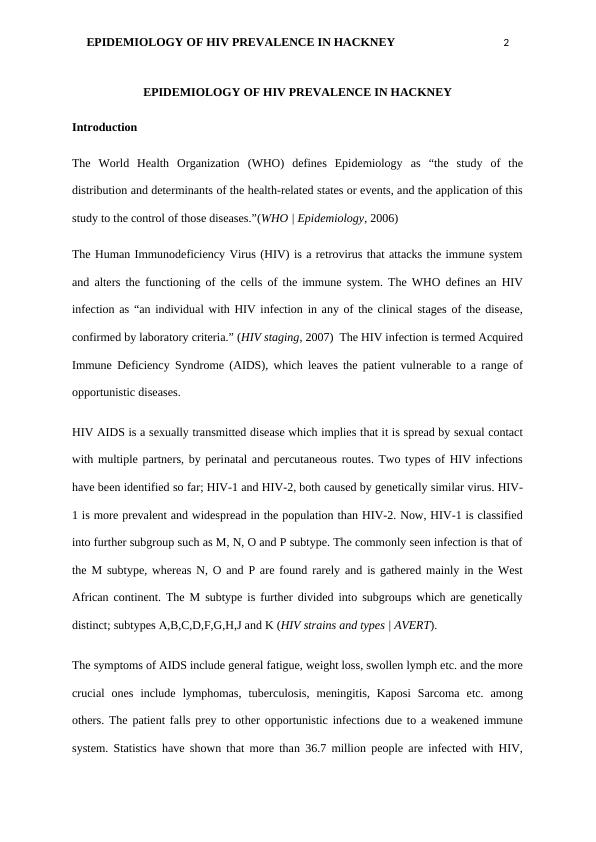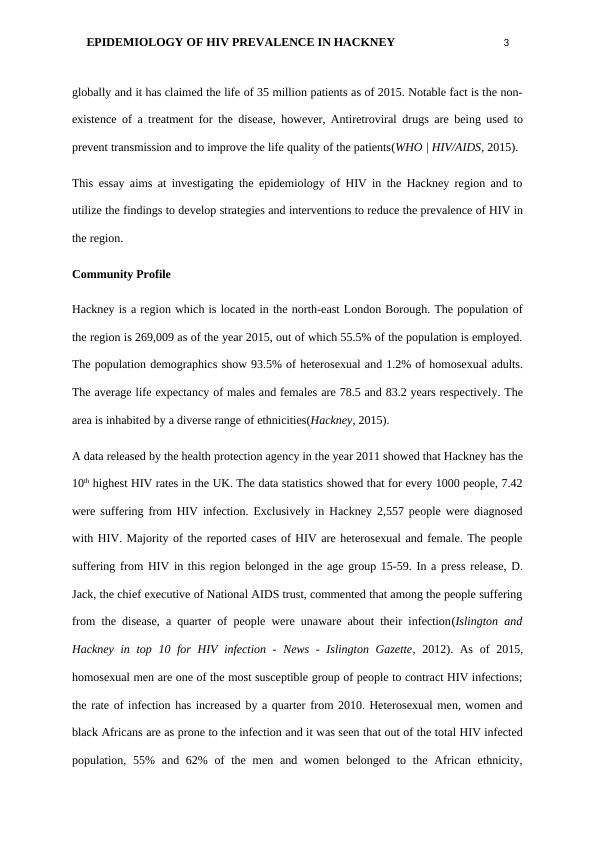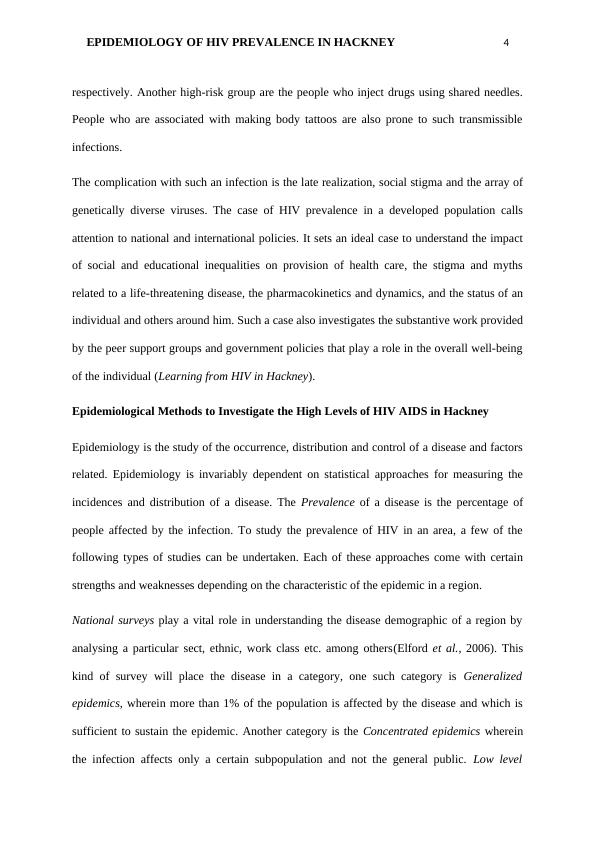Ask a question from expert
World Health Organization (WHO) Defines Epidemiology
13 Pages3676 Words133 Views
Added on 2020-02-05
World Health Organization (WHO) Defines Epidemiology
Added on 2020-02-05
BookmarkShareRelated Documents
EPIDEMIOLOGY OF HIV PREVALENCE IN HACKNEY 1Epidemiology of HIV prevalence in HackneyStudent's Name:Instructor's Name:Date:

EPIDEMIOLOGY OF HIV PREVALENCE IN HACKNEY 2EPIDEMIOLOGY OF HIV PREVALENCE IN HACKNEYIntroductionThe World Health Organization (WHO) defines Epidemiology as “the study of thedistribution and determinants of the health-related states or events, and the application of thisstudy to the control of those diseases.”(WHO | Epidemiology, 2006)The Human Immunodeficiency Virus (HIV) is a retrovirus that attacks the immune systemand alters the functioning of the cells of the immune system. The WHO defines an HIVinfection as “an individual with HIV infection in any of the clinical stages of the disease,confirmed by laboratory criteria.” (HIV staging, 2007) The HIV infection is termed AcquiredImmune Deficiency Syndrome (AIDS), which leaves the patient vulnerable to a range ofopportunistic diseases.HIV AIDS is a sexually transmitted disease which implies that it is spread by sexual contactwith multiple partners, by perinatal and percutaneous routes. Two types of HIV infectionshave been identified so far; HIV-1 and HIV-2, both caused by genetically similar virus. HIV-1 is more prevalent and widespread in the population than HIV-2. Now, HIV-1 is classifiedinto further subgroup such as M, N, O and P subtype. The commonly seen infection is that ofthe M subtype, whereas N, O and P are found rarely and is gathered mainly in the WestAfrican continent. The M subtype is further divided into subgroups which are geneticallydistinct; subtypes A,B,C,D,F,G,H,J and K (HIV strains and types | AVERT). The symptoms of AIDS include general fatigue, weight loss, swollen lymph etc. and the morecrucial ones include lymphomas, tuberculosis, meningitis, Kaposi Sarcoma etc. amongothers. The patient falls prey to other opportunistic infections due to a weakened immunesystem. Statistics have shown that more than 36.7 million people are infected with HIV,

EPIDEMIOLOGY OF HIV PREVALENCE IN HACKNEY 3globally and it has claimed the life of 35 million patients as of 2015. Notable fact is the non-existence of a treatment for the disease, however, Antiretroviral drugs are being used toprevent transmission and to improve the life quality of the patients(WHO | HIV/AIDS, 2015). This essay aims at investigating the epidemiology of HIV in the Hackney region and toutilize the findings to develop strategies and interventions to reduce the prevalence of HIV inthe region.Community ProfileHackney is a region which is located in the north-east London Borough. The population ofthe region is 269,009 as of the year 2015, out of which 55.5% of the population is employed.The population demographics show 93.5% of heterosexual and 1.2% of homosexual adults.The average life expectancy of males and females are 78.5 and 83.2 years respectively. Thearea is inhabited by a diverse range of ethnicities(Hackney, 2015).A data released by the health protection agency in the year 2011 showed that Hackney has the10th highest HIV rates in the UK. The data statistics showed that for every 1000 people, 7.42were suffering from HIV infection. Exclusively in Hackney 2,557 people were diagnosedwith HIV. Majority of the reported cases of HIV are heterosexual and female. The peoplesuffering from HIV in this region belonged in the age group 15-59. In a press release, D.Jack, the chief executive of National AIDS trust, commented that among the people sufferingfrom the disease, a quarter of people were unaware about their infection(Islington andHackney in top 10 for HIV infection - News - Islington Gazette, 2012). As of 2015,homosexual men are one of the most susceptible group of people to contract HIV infections;the rate of infection has increased by a quarter from 2010. Heterosexual men, women andblack Africans are as prone to the infection and it was seen that out of the total HIV infectedpopulation, 55% and 62% of the men and women belonged to the African ethnicity,

EPIDEMIOLOGY OF HIV PREVALENCE IN HACKNEY 4respectively. Another high-risk group are the people who inject drugs using shared needles.People who are associated with making body tattoos are also prone to such transmissibleinfections. The complication with such an infection is the late realization, social stigma and the array ofgenetically diverse viruses. The case of HIV prevalence in a developed population callsattention to national and international policies. It sets an ideal case to understand the impactof social and educational inequalities on provision of health care, the stigma and mythsrelated to a life-threatening disease, the pharmacokinetics and dynamics, and the status of anindividual and others around him. Such a case also investigates the substantive work providedby the peer support groups and government policies that play a role in the overall well-beingof the individual (Learning from HIV in Hackney).Epidemiological Methods to Investigate the High Levels of HIV AIDS in HackneyEpidemiology is the study of the occurrence, distribution and control of a disease and factorsrelated. Epidemiology is invariably dependent on statistical approaches for measuring theincidences and distribution of a disease. The Prevalence of a disease is the percentage ofpeople affected by the infection. To study the prevalence of HIV in an area, a few of thefollowing types of studies can be undertaken. Each of these approaches come with certainstrengths and weaknesses depending on the characteristic of the epidemic in a region.National surveys play a vital role in understanding the disease demographic of a region byanalysing a particular sect, ethnic, work class etc. among others(Elford et al., 2006). Thiskind of survey will place the disease in a category, one such category is Generalizedepidemics, wherein more than 1% of the population is affected by the disease and which issufficient to sustain the epidemic. Another category is the Concentrated epidemics whereinthe infection affects only a certain subpopulation and not the general public. Low level

End of preview
Want to access all the pages? Upload your documents or become a member.
Related Documents
Public Health Intelligence Sample Assignmentlg...
|20
|4201
|82
Communicable Diseases: Global HIV Epidemiology, Role of Agent, Host and Environmental Factorslg...
|18
|5405
|228
HIV and AIDS: Definition, Causes, Symptoms, and Preventionlg...
|8
|2173
|44
Infectious Disease - HIV in Indialg...
|10
|2380
|12
Critical Analysis of HIV/AIDS and Ischaemic Heart Disease in Indialg...
|21
|1441
|83
Communicable Diseases: Causes, Symptoms, Complications, and Managementlg...
|10
|2184
|311